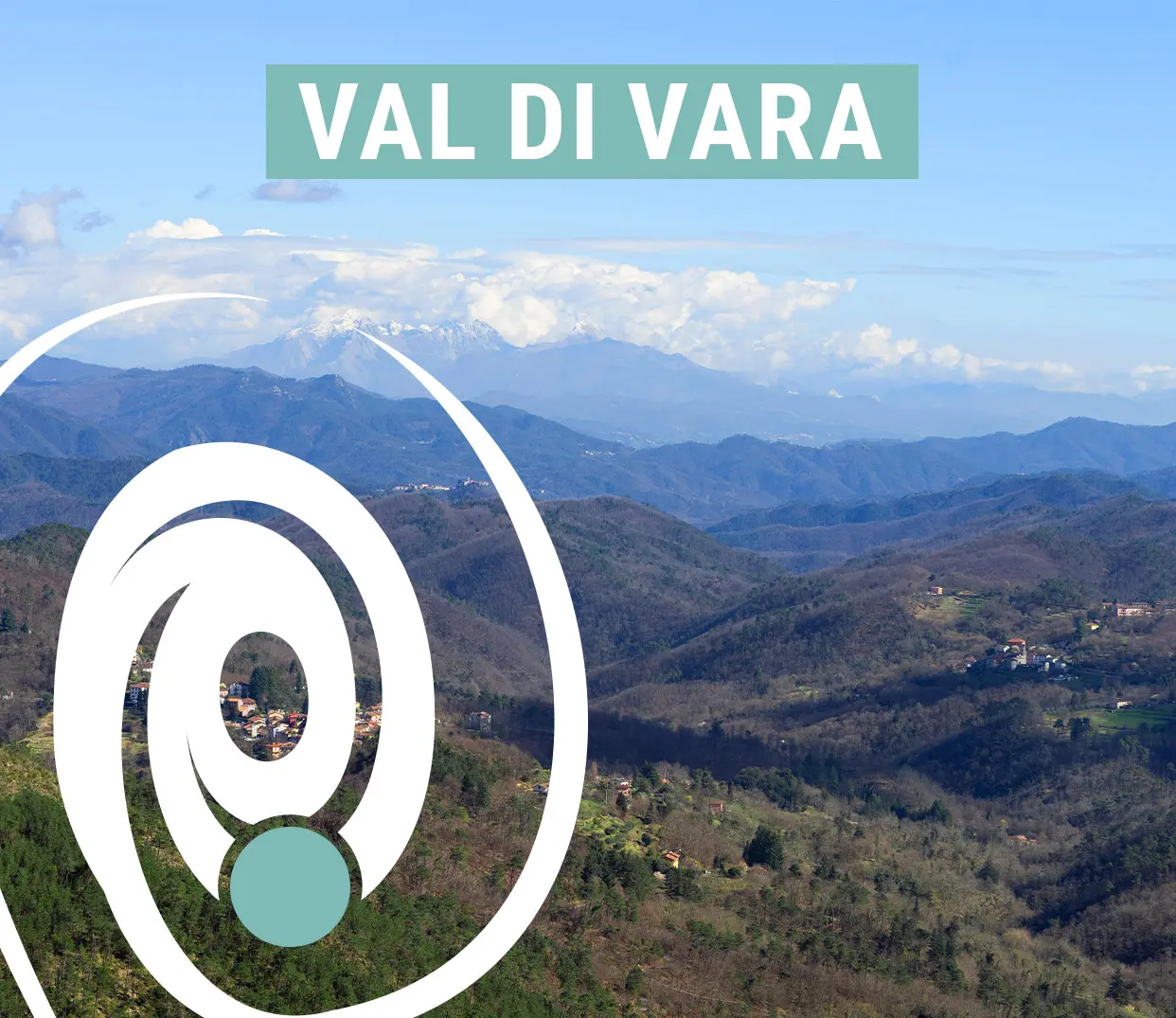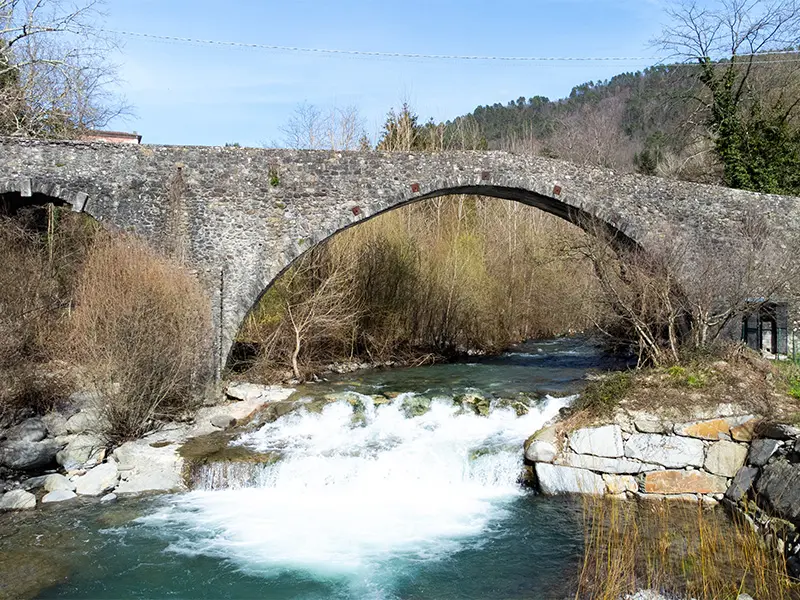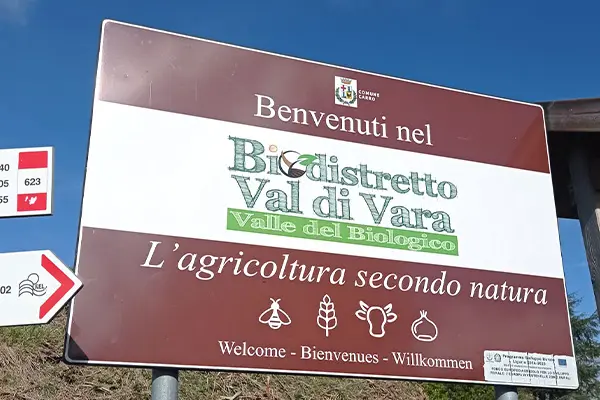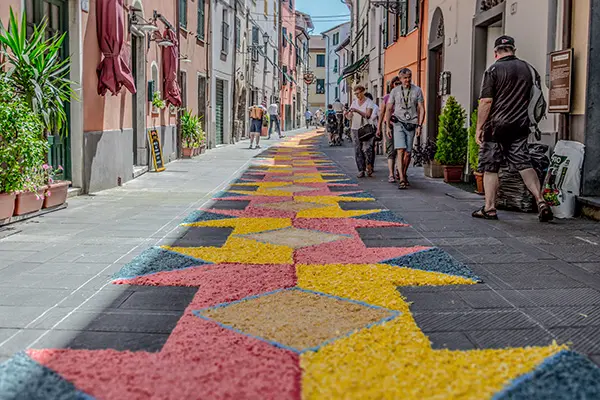

The Val di Vara is located in the province of La Spezia, inland Liguria, behind the Cinque Terre. The valley, a few kilometres from the sea at Levanto and Bonassola, borders Tuscany and Emilia Romagna. Divided into Alta, Media and Bassa Val di Vara (Upper, Low and Mid Val di Vara), it owes its name to the river Vara, which runs through it longitudinally for 58 km.
The river rises from Monte Zatta to flow into the Magra, of which it is the largest tributary, at the level of the Santo Stefano di Magra plain at Fornola.
In 2020, The Guardian, one of the most authoritative British newspapers, reported the Alta Val di Vara, also known as the Organic Valley, as one of the twenty most alternative places in the world to spend a holiday for the beauty of the landscape and the biodiversity of the area.

 Territory
Territory
Defined as the greenest valley in Italy thanks to its dense vegetation, the Val di Vara appears as a hortus conclusus: a garden, from the Cinque Terre to the first high grounds of the Apennines, rich in panoramic views, Mediterranean scrub and points of interest, such as the various Romanesque churches, immersed among chestnut, pine and oak trees.
The valley is bordered by Mount Zatta (1407 m.), where the Vara river has its source, Mount Zuccone (1423 m.), Mount Porcile (1249 m.) and Mount Gottero (1640 m.), a conformation that separates it from the valleys of Parma. To the south-east, Monte Fiorito (1093 m.) and Monte Cornoviglio (1162 m.) separate the valley from Lunigiana (Province of Massa).


In Val di Vara there are important archaeological presences such as the Lagorara site in the municipality of Maissana and the Cota site in the municipality of Carro.
Characterising the valley from an architectural point of view are the ’round hamlets’, settlements of medieval origin whose urban roots are to be found in the ‘castellari’, structures built in prehistoric times by the first Ligurian tribes. Traces of these stone belts, on heights overlooking the valley, can still be found at Zignago, Vezzola, Pignone and at Castelfermo in Carro.

CLICK AND BROWSER

CLICK AND BROWSER
 Culture
Culture
The Val di Vara is an open-air museum where medieval hamlets, many of them in stone, offer interesting architectural elements with ancient marble or slate portals and palaces with façades painted in the Ligurian tradition. The churches and oratories in the area themselves reveal sculptures, bas-reliefs and paintings of great interest that are still little known to the general public.
The territory has been able to combine the traditions linked to the farming civilisation with the promotion of organic production and the protection of agro-biodiversity, considering that seven municipalities – Carro, Carrodano, Maissana, Rocchetta Vara, Sesta Godano, Varese, Ligure, Zignago – belong to the Val di Vara Biodistrict recognised by the Liguria Region.
There are numerous religious festivals and popular fairs organised to celebrate events related to the sacred or to celebrate the spring, the grape harvest, the honey and chestnut harvest or the mushroom season.
And there are many events that take place every year, such as the Paganini Festival in Carro, with concerts in the hamlets of the valley, the Pignona Sweet Onion Festival in Sesta Godano, the Val di Vara Book Festival in Varese Ligure with two days of events with authors and publishers, the Festival of Peasant Culture in Vezzanelli-Zignago with workshops dedicated to agriculture, and the Valle Bio Festival in Varese Ligure dedicated to the territory’s organic producers.

TYPICAL PRODUCTS
The typical products of the Val di Vara are an expression of an area characterised by organic farming. In Varese Ligure, along with the most important organic beef farms, the tradition of 'croxetti' is alive: the traditional fresh pasta in the shape of small discs still made with handmade moulds.
In addition to classic ravioli with a 'prebuggiun' filling, typical products include chestnut flour and pasta, mushrooms, the red onion of Pignona and a wide variety of honeys with different essences. Among the cheeses, the 'borgorotondo', a soft-cut cheese with a special salting, stands out, while among the desserts, the 'canestrelli di Brugnato' with aniseed seeds and the 'ciambellone di Carro' are not to be missed.
For lovers of artisan beer, Torza is interesting, while in Carro, Calcinara and Cornice it is possible to discover different wines thanks to the establishment over the years of vineyards by wineries of great excellence.

CORPUS DOMINI INFIORATA IN BRUGNATO
Every year on Corpus Christi day (30 May), the traditional “infiorata” takes place in Brugnato. The main streets of the hamlet, covering 1.5 km, are covered in a floral carpet, with designs on religious and Eucharistic themes, created with the petals of more than 10,000 flowers from the five districts of the historic hamlet.
Small altars full of flowers are set up in the most significant corners of the hamlet as a tribute to Corpus Christi, and satin bedspreads and traditionally embroidered blankets are hung in the windows.
The event ends with the Corpus Christi procession through the streets and on the flower carpet.

CASSEGO PEASANT MUSEUM
In the upper Val di Vara, in Càssego, a hamlet of Varese Ligure, we find the Peasant Museum. It is located in the centre of the village, opposite the 17th-century church dedicated to St Bartholomew, in the former 'Caterina Schiaffino' primary school.
It is home to more than 500 ethnographic exhibits documenting the everyday life of farmers in the Ligurian mountains. The old workshop trades and the main production activities are illustrated through thematic routes. These activities include the processing of milk, chestnuts, wheat, maize, wine, cider and hemp.
 Cathedral, Parishes, Shrines and Oratories
Cathedral, Parishes, Shrines and Oratories
The religious history of the Val di Vara has its centre in Brugnato, which originates, in the 7th century, from the Benedictine Abbey founded, according to tradition, by Saint Columbanus to whom, together with Saint Peter and Saint Lawrence, the Cathedral, next to the Diocesan Museum, is dedicated.
In each hamlet there are one or more churches to visit. The system of ecclesiastical organisation had its centres in the baptismal churches (pievi), which gave rise to a series of smaller churches under their dependencies (chapels), which in time broke away and became autonomous parishes.
There are several Sanctuaries, often dedicated to the Virgin Mary. These Sanctuaries are in places that bear witness to a miraculous apparition of the Virgin, and near springs, caves, and forests, proving Christian devotion over pagan places of worship.
Objects of particular devotion are the Sanctuary of the Madonna del Dragnone in Zignago, overlooking a vast panorama, built on the site of an earlier pre-Christian cult, and the Sanctuary of Our Lady of Roverano, which was built in 1518 and enlarged in the 19th century to accommodate the ever-increasing number of worshippers.
In the Val di Vara, there are many oratories that are seats of confraternities, associations born in the Middle Ages that continue to carry out, as in the past, charitable tasks.
 Val di Vara, land of castles
Val di Vara, land of castles
Castles, fortifications of medieval origin that also served as the residence of feudal lords, are scattered throughout the Val di Vara. In many hamlets there is evidence of a fortified building, such as in Cornice, Ponzò, Groppo, Chiusola and Godano, razed to the ground by the inhabitants after the murder in 1525 of Alessandro Malaspina, the local feudal lord.
Among those that have retained their original layout and can be visited are the Suvero Castle, the Calice al Cornoviglio Castle, home to the Beekeeping Museum and the Beghè Art Gallery, and the Fieschi Castle in Varese Ligure with its characteristic round hamlet. The Malaspina castle of Madrignano, at an altitude of approximately 400 metres, dominates from above the wide plain of the Vara river up to its natural outlet in the coastal area. In Ceparana we find the Giustiniani Castle with its square tower and the remains of the Abbey dedicated to San Venanzio.



